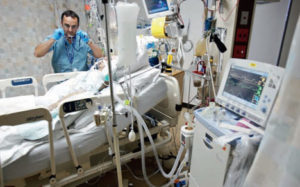By Danny Tran and Elijah Exley; Farnsley Middle School (Louisville, KY)
Teacher: Marsha Buerger
“Take care of your mom. I love you son,” is what Elijah thought were his father’s last words.
In November of 2015, Todd Exley, co-author Elijah Exley’s father, contracted an unknown condition. He was coughing, vomiting, and had a fever of over 101 ˚F. At the hospital, Exley was diagnosed with sepsis. Elijah and his mother were scared because they had never heard of sepsis. After a few days in the hospital, it appeared that Exley’s condition was getting worse.

According to the Mayo Clinic, sepsis can cause the body to be extremely tired and confused. Other symptoms include paleness, decreased urine output, change in mental status, difficulty breathing, and lower platelet count. Exley had a lung infection, but as time went on the infection got worse and worse until he contracted sepsis.
According to the Mayo Clinic, people can get sepsis from having pneumonia, abdominal infection, kidney infection, lung infection, or blood infection (bacteremia). Sepsis is increasing in the US because of certain factors, such as an aging population and more drug-resistant bacteria that are not affected by antibiotics. Sepsis is common if you are very old or young, have a weak immune system or already sick, have wounds, and use a catheter or breathing tube.
According to Sepsis Alliance, “258,000 people die from sepsis each year and 4,400 out of the 42,000 children that develop sepsis, die from it, Sepsis is the third leading cause of death in the US and is the first leading cause of child death and infant mortality.”
In a recent email from Dr. Ivan Marazzi, Ph.D. and Assistant Doctor in Microbiology at Mount Sinai Hospital in New York, “It can be brought on by different pathogens and there is no protection from it. People are able to re-get it, more likely by a different pathogen. Since the immune system generates T cells that ‘memorize’ the encounter with a pathogen to respond better in a subsequent infection, this is why it’s unlikely to get sepsis from the same pathogen.”
According to tcells.org at Cardiff University in England, “T-cells are a type of white blood cell that circulate around our bodies scanning for cellular abnormalities and infections.” T-cells help the immune system in different ways. The two different types of T-cells are killer T-cells and helper T-cells. Killer T-cells kill the infected cells, while the helper T-cells make an immune response to the threat. They memorize, or remember the pathogen so that you can’t get it again.
According to the Mayo Clinic, sepsis can be diagnosed several ways, including X-ray scans, urine output, and a blood test. The blood test is the most common way to diagnose sepsis.
According to Marzari, “There is no real cure for sepsis, but there is a treatment. The treatment that is the most common way is to use wide-spectrum antibiotics to fight the infection. Usually it’s not enough or it’s too late and the antibiotics do not fight the infection in time, which causes often, unfortunately, death”.
Other treatments include vasopressors, which are drugs that cause blood vessels to tighten, surgery, and supportive care.
To prevent this disease, people should get vaccinated against the flu and pneumonia, and should clean themselves.
“I had to have antibiotics pumped in to my system to fight the infection, which made me sick,” says Exley.
This affected his immune system, which was much weakened, and made him sick. This was very different from sepsis, even though sepsis does affect the immune system. The antibiotics were given by IV, which means administered intravenously, and the nurse had to stick him with a needle 7 times to get the antibiotic in him.
As of today, Exley is feeling “much better”. He is very alert and energetic. He has not been hospitalized since the diagnosis. It took three weeks for Mr. Exley to fully recover from sepsis.
“I feel alive again. My body does not feel like I’m dragging around anymore,” he adds.

This work is licensed under a Creative Commons Attribution-NonCommercial-NoDerivs 3.0 Unported License













